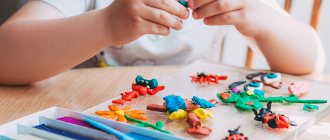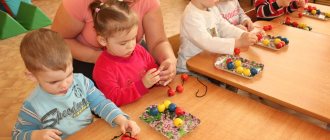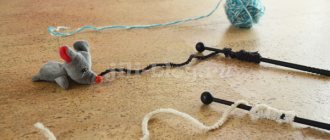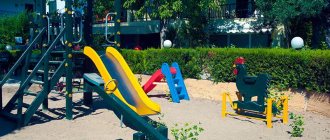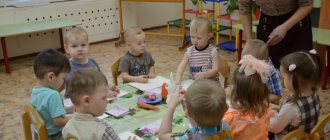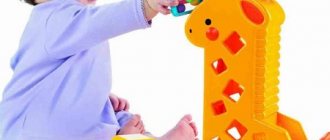- Course duration – 10 months (80 lessons)
- Frequency – 2 times a week
- Lesson duration – 50 minutes
- Children study with mothers
- The set includes 80 notes with illustrations and music files.
This course is aimed at the comprehensive development of a child aged 2 to 3 years.
We place our main emphasis on the intellectual direction - teaching reading and mathematics, developing speech, studying the world around us, developing attention, memory, logic, and thinking. However, the course also contains other elements - creative crafts, listening to classical music, dynamic pauses aimed at developing the child’s gross motor skills. View an example of a summary →
Topics of notes:
September
1. Meeting of friends 2. Learning to be friends 3. Hello, windy breeze 4. Breeze and rain 5. Orchard 6. Vitamin boost 7. Gifts from the village 8. What grows in the garden
October
9. Who lives on the farm 10. Domestic animals and their babies 11. The chicken is looking for its mother 12. The chicken and the duckling 13. Lost supplies 14. Forest animals 15. Trees 16. Trees. Miraculous transformations
November
17. Wild birds 18. Birds in the city 19. Matryoshka 20. Favorite toys 21. Box of pencils 22. Magic paints 23. Pyramid 24. Ball
December
25. Fun tea party 26. Dishes 27. What’s for lunch today 28. Edible and inedible 29. This is Africa! 30. Elephants and giraffes 31. Visit the penguins! 32. Polar bears
January
33. White in winter, gray in summer 34. Teddy bear 35. House 36. Everyone in the world needs a house 37. Long live scented soap 38. Good Doctor Aibolit 39. Big and small 40. Hot and cold
February
41. Round-square 42. Day and night 43. Clothing 44. Clothing 45. Shoes 46. Generalization. Shoes and clothes 47. Dad's helpers 48. Watches
March
49. Helping mom 50. Grandma visiting 51. Household appliances 52. Where the sparrow dined 53. Elephant’s birthday 54. Let’s go to the theater 55. Telephone 56. Rainbow
April
57. Sea trip 58. Fish 59. Furniture 60. Furniture 61. Shopping 62. I love my horse 63. Such different cars 64. Train
May
65. Air travel 66. Transport. Generalization 67. Flowers 68. Ladybug 69. Butterflies 70. Ant 71. Bee 72. Frog
June
73. Snail 74. Turtle 75. On a forest path 76. Dandelions 77. Water Sorceress 78. Kittens and gloves 79. Magician 80. Dunno visiting a baby
Which plasticine modeling is suitable for a 2 year old child?
For sculpting you can use:
- Regular plasticine
- Plasticine dough (Play-Doh)
- Homemade salty dough
What can be molded:
- Tubes
- Balloons
- Flat figures
- Imprinting shapes with molds
- Below in the pictures see figurines for sculpting for 2 year olds.
Flower figurine
Candy made from plasticine tubes
Caterpillar made of plasticine balls
What do you get when you purchase this set of notes?
- You receive 80 notes for classes with children from 2 to 3 years old for 10 school months, 2 times a week,
- Illustrations for all notes:
- Colorful pictures for the block “The world around us” for printing or displaying on the screen through a projector
- Black and white worksheets for the unit "Preparing the hand to write" (children take home)
- Creative block illustrations when needed
- Files with musical or sound accompaniment (for example, the sound of water, the roar of an animal, the chimes, a folk song), when this does not violate anyone's copyright. In other cases, we give instructions on how you can purchase a disc with this melody.
And bonuses:
Bonus #1 . A list of everything you will need for classes - toys, teaching aids, stationery and much more.
Bonus #2 . Scenarios for three holidays for children of this age. The scripts have been worked out and contain recommendations for the design of premises, descriptions of props, costumes and scenery, and musical accompaniment.
What dances are suitable for a 2 year old child?
After 2 years, the child is just beginning to understand his body and walk confidently. Psychologists recommend that a child start dancing from the age of 5, but if the child is active and wants to attend classes, then you should definitely send him to those groups where the children will be of the same age (2-3 years). Dancing at this age is more like active games with movements to music, however, this can become an important part of the child’s physical development.
What movements are suitable for babies:
- Jumping to the music
- Round dances
- Swing your arms up, to the sides, forward and back
- Elevated leg movements
- Jumping from leg to leg
- Head movements left and right
- Pelvic movements
Reviews
According to our notes, hundreds of children's centers in Russia and the CIS countries are already operating. They received the approval of not only practical teachers, leaders of children's clubs, but also very respected representatives of the scientific community.
Podvoisky V.P., professor, Doctor of Pedagogical Sciences, Candidate of Psychological Sciences, member of the educational and methodological council for early childhood development, professor of the Department of Psychology at Moscow Pedagogical State University:
“The considered methodology of Yu. Belotserkovskaya and Z. Ivanter represents interesting material, which is sufficiently updated in the light of reforming the modern system of preschool education...”
“The components of the classes (greeting, warming up, reading, logorhythmics, mathematics, studying the properties of objects, general motor, finger gymnastics, artistic and creative activities / applique, drawing, modeling /, farewell) not only correspond to the natural course of dramaturgy, but also allow you to engage emotionally -sensory, visual-motor, tactile-auditory perception of children..."
“In such psychological and pedagogical conditions, the time frame of attention expands, and memory begins to intensify its work...”
“The applications used in the methodology are not just a colorful addition, but are organically woven into the content of the plot and semantic lines. They allow you to make the necessary accents, switch attention and continue to “swim children on the wave of new knowledge”...
“The analyzed methodology should be published in a good edition so that it becomes fully accessible to Early Childhood Development Centers.”
Blokh O.A., Doctor of Pedagogical Sciences, Professor of the Department of Pedagogy and Psychology, member of the Union of Writers of the Russian Federation, General Director of Children's, Vice-President of the International Academy of Informatization at the United Nations (department of music, education):
“The methodology […] arouses interest and deserves attention at the structural, content and technological levels. The methodology includes lesson notes, checklists (list of materials used, props, developmental elements), various musical, visual and artistic applications. The structure of the lesson represents a holistic system construction and accumulates such important components as greeting, warm-up, reading, logarithmics, mathematics, studying the properties of objects, general motor, finger gymnastics, artistic and creative activities (appliqué, drawing, modeling, etc.), farewell ( the final). Each section of classes has its own target setting...”
“It should be noted as a positive aspect the creation of a creative environment in the classroom through the active participation of children, parents and teachers in the developmental process based on the development of a culture of communication and a culture of behavior. In this method, the processes of training and education are naturally intertwined and form a harmonious whole...”
“It is important to pay attention to the fact that all the material in the methodology fully complies with the principles of health-preserving pedagogy and meets the multifaceted specifics of the early holistic development of children...”
“The methodology can be published in a scientific and methodological publication and serve as the basis not only for practical activities, but also for scientific and creative research...”
View original reviews in full for all courses
What crafts does a 2 year old child need?
Things to do with your child:
- Application made of colored paper. Using dry glue (for neat and quick work). Allows you to get acquainted with colors and odds.
- Modeling from plasticine. You can replace it with plasticine dough or salt dough, learning the structure, shapes, and developing motor skills.
- Application made of cotton wool and cotton sponges. Allows you to create voluminous applications.
- Crafts from cereals. This is not only an active development of hand motor skills, but also an interesting activity for the child.
- In the pictures below, see examples of crafts and applications for 2 year olds.
Crafts from cereals for a 2 year old child
Crafts with cotton wool
Crafts made from colored paper
Crafts from salt dough and plasticine for 2 year olds
Crafts with colored and corrugated paper
Cost of a set of notes
| 1 month | 8 fully written notes + Illustrations for notes + Sound files (the sound of rain, animal voices, chimes, folk songs, etc.) | 4000 rub. |
| 5 months | 40 fully written notes + Illustrations for notes + Sound files (the sound of rain, animal voices, chimes, folk songs, etc.) | 16,000 rub. |
| 10 months | 80 fully written notes + Illustrations for notes + Sound files (the sound of rain, animal voices, chimes, folk songs, etc.) + Bonus No. 1. List of all toys, teaching aids and stationery that will be required for classes + Bonus No. 2. Scenarios for three holidays | 30,000 rub. |
If you have ever been interested in the question of building an educational process in a children's center, you immediately realized how attractive this offer is. When purchasing a complete set of notes, one month costs 3,000 rubles. In Moscow, this is the cost of one monthly subscription. That is, one new client will already recoup your investment in notes. (Outside Moscow, this is the cost of three or four subscriptions. This means that your investment will return three or four new clients).
At the same time, the presence of this curriculum in the club will attract not just a few, but dozens of new students.
What outdoor games does a 2 year old child need? How to play with a 2 year old child?
How to entertain a child:
- Ball games (football, basketball, water polo, golf, tennis).
- Catch-up (game between children or with parents)
- Hide and seek (game with children and parents)
- Games with juice (catch a ball, butterfly, ball)
- Games with soap bubbles (blow and catch)
- Biking and scootering
- Games in children's labyrinths
- Fishing
- Jumping on a trampoline
IMPORTANT: Parents need to instill a love of active outdoor games in their children, enjoy spending time with their children and actively participate in entertainment.
How quickly will you receive your notes?
Very fast. Previously, we sent material on disk, but due to disruptions in the work of postal operators, we abandoned this practice and introduced the transfer of information through a personal account.
How does this happen? We will send you a login and password so that you can log into your personal account and save all materials on your computer. The information is not stored on a disk, which can be scratched, broken or lost, but on your computer. You will receive your order quickly and in an easy-to-use form.
So if you want:
- Have a consistently high quality of classes, ensured by documented processes
- Save on teachers' salaries by attracting young specialists
- Do not depend on the whims of star teachers
- Minimize the risk of losing clients due to teachers leaving
- Conduct classes according to a program that has already been worked out by other successful children's centers and highly qualified teachers
- Work in the most productive mode, without being distracted by buying study guides and drawing handouts
- Attract more clients by explaining to parents that the club has its own methods of child development, telling in detail about the classes provided
- Spend holidays with children according to detailed and worked out scenarios, including descriptions of props,
then this kit may come in handy.
What rhymes does a 2 year old child need?
Games, bathing, eating and dressing the baby can be combined with reading rhymes. This will allow you to turn any process, even the most boring and disliked by the baby, into fun and play.
Our Tanya is crying loudly , she dropped a ball into the river. Hush, Tanya, don't cry! The ball won't drown in the river! A duck swam past and handed Tanya a ball.
Bath rhyme
Rhyme for the game
Educational rhymes for 2 year olds
Poem for games and entertainment
Rhyme for games
Myths about the early development of babies under one year old
Unfortunately, there are parents who avoid infant activities due to prejudice and lack of information. But in practice, the real reason for the reluctance to devote time to children in terms of educational games is often laziness and reluctance to develop themselves. Why is this so? Let's compare the myths with reality.
| Stereotype | Real picture |
| Standard training programs are transferred to an early age | Infant activities have nothing in common with school or even kindergarten education. Their task is to create favorable conditions for unlocking the baby’s potential, motor and sensory development, psychological and physical health. |
| Western "fashionable" concept | Innovations in this field are being implemented throughout the world and have proven their effectiveness in contributing to the global education system. |
| Not necessary | Practice shows that people whose parents used early development methods are more successful, capable and able to achieve more. They outperform their peers in childhood, adolescence and adulthood. |
| Expensive | Nowadays, all quality children's toys cost money, and it is better to spend it wisely. In addition, there are many options for making educational toys yourself and quickly, using inexpensive, safe materials. |
| Children are deprived of their childhood | Kids are inquisitive and like everything new. None of the methods for newborns is based on coercion, on the contrary, on interest and positive emotions. |
| There is no ideal technique that you can strictly follow | Not everyone is suitable for the same method; each technique is general recommendations, not strict instructions. No one forbids using the best elements of different methods, selecting them individually for your child. |
An integrated approach to teaching children
How to organize classes with an impulsive, active child who cannot yet concentrate on one type of activity for a long time?
It should be noted that this behavior is largely a feature of this age. The baby’s skeleton and muscles are just developing, and at this stage of development the body is not yet able to remain in the same static position for a long time. Therefore, quiet activities that require attention and concentration should be combined with active games.
The peculiarities of the mental activity of a young child are such that he cannot concentrate on one type of activity for a long time and quickly gets tired.
The baby’s attention is also short-lived, and sometimes “field behavior” takes place: the child moves in space, striving for an object that has attracted his attention, but as soon as the child reaches it, another object comes into his field of vision - and the baby rushes towards it, forgetting about it. first. It is clear that such chaotic behavior does not bear fruit, because the child does not truly examine objects.
Therefore, during the lesson, an adult must regulate the child’s behavior: the adult makes special efforts to interest the child in some kind of game, and during the game he watches the baby - at the first sign of fatigue or loss of interest, you need to end this game and start a completely different one.
In addition, it must be taken into account that a small child can fully study only if he is well-fed, satisfied and not busy with any activity that is important to him, and it is better not to take him away from it for the sake of studying. Nevertheless, it is quite possible to smoothly transform the baby’s activity into a real educational game (of course, independent activity also develops the baby, but a specially organized educational activity has a different quality and usually develops and teaches at a higher level).
Thus, if desired, we can fit from 2-3 to 4-8 diverse mini-games into one full-fledged lesson with a child. For example,
- While the child is full of energy, we start with the most difficult thing - speech development (for example, we read 2-3 pages from a special book and look at the pictures or finish the words in a familiar nursery rhyme);
- then we invite the child to “feed the mouse” - put the beans into a jar with a hole in the lid, thus developing the baby’s fine motor skills;
- After that, we get up from the table and play the outdoor game “Repeat after me!” (imitation of the movements of an adult);
- then we return to the table and draw straight lines with felt-tip pens - “strings for balls”;
- after drawing, we sit down on the carpet and “build houses”, selecting cubes and prisms of the same color and thus studying the colors;
- You can end the lesson with something very pleasant for the child - for example, an emotional game of hide and seek, in which a large scarf is used (in this case, the baby will have a particularly pleasant memory of the lesson, he will look forward to the next one).
This is what a comprehensive activity with a baby is like. Each game lasts several minutes, and the number of games can be flexibly changed depending on the child’s condition.
If the mother is working with the child at home, you can play these games throughout the day, taking breaks between them.
Where can you go with a 2 year old child?
In modern big and small cities there are always entertaining and educational rooms for children:
- Indoor playgrounds
- Trampolines and mazes
- Montessori school for little ones
- Drawing lessons (any creativity)
- Dance and gymnastics club
Where else can you go with a 2-year-old child:
- To the dolphinarium
- In the pool
- To the park (lunar park, amusement park)
- To the zoo
- To the puppet theater
What cartoons are suitable for children 2 years old and how long can they watch TV?
Pay attention to these cartoons:
- Merry Carousel is an old Soviet serial cartoon with a modern continuation. The cartoon is full of funny music and instructive stories.
- Tiny Love (dubbed) is a cartoon designed for children from 1 year of age, it has a lot of music, educational and developmental moments.
- Malyshariki is a cartoon with funny characters that teach children to behave correctly in different life situations and develop them.
- Masha and the Bear is a cartoon with a good sense of humor that teaches children to behave correctly, learn about the world, make friends and have fun.
IMPORTANT: You can choose a suitable cartoon on any video hosting site, the main thing is to adhere to the search criteria and select cartoons of the appropriate age (2 years). Cartoons should teach colors, shapes, shapes, and new words.
In terms of the duration of TV viewing, focus on episode 1 of the cartoon “Masha and the Bear a Day” plus “Good Night Kids” in the evening, lasting 15 minutes. Total 30 minutes a day. This is the norm.
Games for babies from 7 to 9 months
This quarter is distinguished by curiosity - children crawl confidently, and by 9 months they are already on their feet. The range of activities is also expanding.
Seventh month
Most babies sit more often at 7 months, so you need to use their arms.
The finger game is the familiar “magpie-crow” verse, in which children take turns bending a finger. This is necessary for motor skills and preparation for manual manipulation.
Bags of cereals – also for fine motor skills, different cereals are poured into different fabric bags. There should be several bags, for example, with beans, rice, buckwheat, and peas. This exercise should be under the supervision of a parent; if the baby starts eating cereals, it is not fatal, but it is extremely undesirable.
A hammer with a squeaker - the child uses it to knock on everything he can reach. This is useful for coordinating movements.
Tactile books - you can make them yourself, using different fabrics, buttons, and other small objects that the child touches with his fingers.
Back in 2006, it was proven that children aged 7 months have mathematical abilities. Alternately, 2 or 3 women said the same word, after which the baby was asked to choose one video frame from two - with two and, respectively, with three women. The children accurately chose the frame with the number of women that matched the number of votes.
Eighth month
There is a great interest in animals, so you need to show your child pictures or toys, animals on the street, and show what sounds this or that animal makes. It is very important that toy and painted animals look more like real ones and not like fantastic non-existent ones.
Studying states - take an ordinary plastic transparent bottle into which cereal is poured or water is poured. The baby shakes, turns the bottle over, twists it and examines how what’s inside behaves and how it sounds.
For those who still crawl poorly, a bright toy is placed not far from the child, to which he must crawl. Subsequently, the toy is gradually placed further and further away. Instead of toys, you can play hide and seek. For example, a mother hides around a corner, a child sees it and crawls to look for it.
Ninth month
Bathroom games with water toys - ducks, boats, windmills and fountains, today there is a very large choice.
Matryoshka, collapsible pyramid with rings - development of motor skills, understanding of different sizes, synchronization of actions.
A box with holes of different shapes - the essence of this game is to pick up an object of the same shape as the hole where it needs to be pushed.
Any games where you need to throw or put different objects into one container, box, or bottle are also good for motor skills. Avoid objects that are too small, especially if leaving your child unattended.


